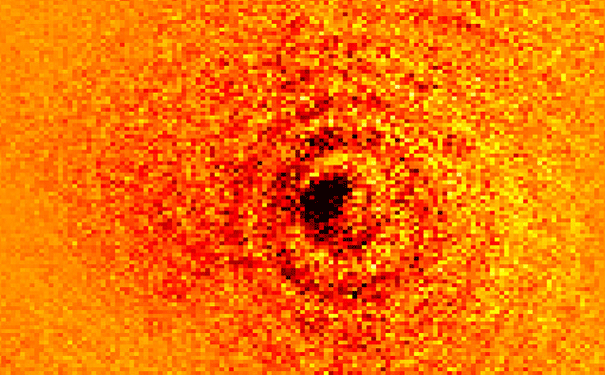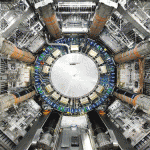
The shadow of a single Ytterbium ion. Image courtesy of Ben Norton
How few atoms do we need to cast a shadow?
It turns out that it’s just one — a research team from Griffith University has succeeded in photographing the shadow of a single atom for the first time. This is the extreme limit of microscopy, as atoms are the smallest things that can be seen with visible light.
“We have created the world’s smallest shadow puppet,” research team member Dr Erik Streed says.
The atom chosen for the experiment was a single Ytterbium (Yb) ion, as the researchers could build lasers of precisely the right colour to excite the atom, according to research team member Ben Norton. “Ytterbium also has the right internal structure to allow us to do quantum computing.”
The Yb atom was isolated in a vacuum chamber and held in free space to ensure that it would hold still long enough for its photograph to be taken. The super high-resolution microscope would then make the shadow cast dark enough to be seen and photographed with a digital camera.
However, getting the light to hit the ion was one of the most difficult parts of the experiment, as they were trying to hit something that was only a few nanometres across. “We started out by trapping a single ion and imaging it on our camera,” Norton says.
“Once we knew where the ion was we were able to direct part of the light from our cooling laser up from the bottom of our trap allowing the beam to be imaged onto our camera.”
The position of the beam and the ion could then be overlapped on the camera, and the angle and position of the beam adjusted until the dark spot from the ion was blackest. This required incredible precision — if the light frequency was altered by just one part in one billion, the image would disappear.
Streed hopes that this imaging process will lead to advances in quantum computing by enabling scientists to find better ways of extracting information from the atoms. The results could also have implications for taking images of tissue such as cells and DNA, which are destroyed by the current processes.
“Because we are able to predict how dark a single atom should be, as in how much light it should absorb in forming a shadow, we can measure if the microscope is achieving the maximum contrast allowed by physics,” Streed says.
“This is important if you want to look at very small and fragile biological samples such as DNA strands where exposure to too much UV light or x-rays will harm the material.”
The photograph has already won acclaim, with Norton taking out the runner’s-up prize in the CiSRA Extreme Imaging Competition earlier this year.






